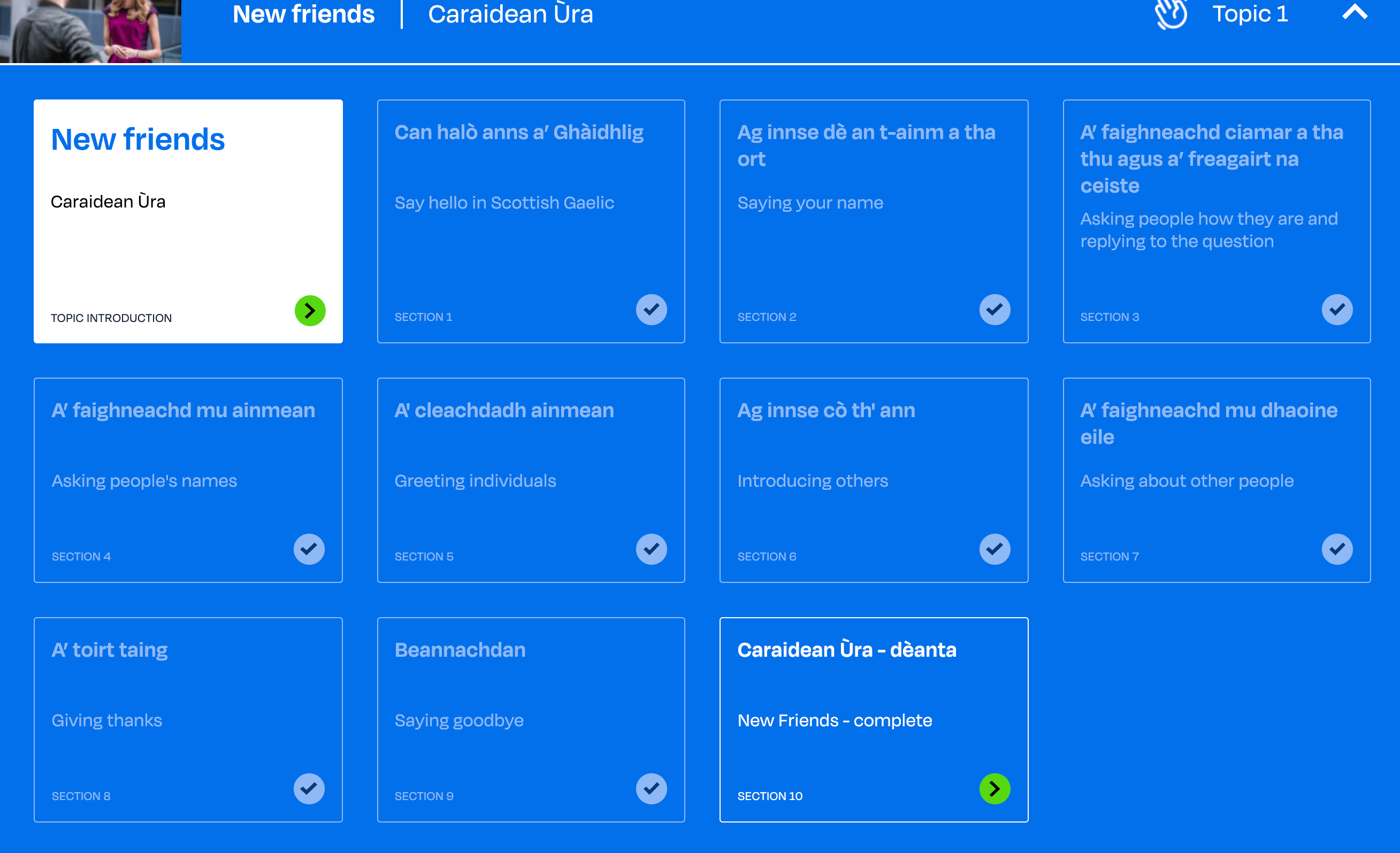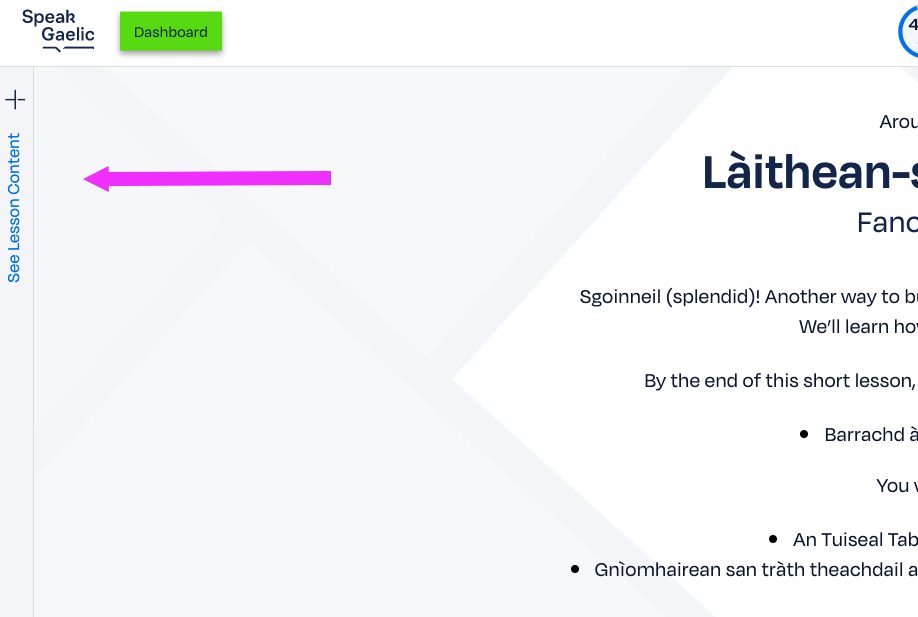Bilingual transcription: Clach Sgàin
Bilingual transcription: The Stone of Destiny
Why not take a trip in the company of Calum MacIlleathain?
Tha mi air a thighinn a dh’àite a tha loma-làn eachdraidh. A place that’s full of history, loma-làn eachdraidh. Eadar na craobhan mòra, làidir seo… An cnoc seo, àite-crùnaidh nan Rìghrean Albannach. The crowning place of Scottish Kings… àite-crùnaidh nan Rìghrean Albannach agus fiù’s stuthan prìseal às gach cèarnaidh.
Càit a bheil mi? Càit eile, ach aig Lùchairt Sgàin! Scone Palace, Lùchairt Sgàin! Nise, Sgàin anns a’ Ghàidhlig-Scone in English… not Scone… or S-cone… Chan ann mu sgona mhilis a tha mi a’ bruidhinn.
Ah! Agus tha fhios ‘am gu bheil mi buailteach a bhith a’ togail air ‘pun’ sam bith a tha a’ nochdadh ann an ainm, ach cha tachair sin an-diugh. Oh cha thachair! Dè a’ Ghàidhlig a th’ air pun… Tha cainnt-chluich: language-play… cainnt-chluich.
Ach saoil dè tha romham an-diugh? I wonder what’s ahead of me today? Saoil dè tha romham? Agus saoil am faigh mi sealladh air na daoine bhon tàinig mi.
Seo Caisealan Credi, neo ‘Moot Hill’ mar a th’ aca air anns a’ Bheurla. ‘The hill of faith’, tha e coltach.
Credi-a’ tighinn bhon fhacal ‘Creideamh’ faith neo belief, creideamh… cha chreid mi nach eil sin ceart… ’S ann an seo a bhiodh Rìghrean na h-Alba air an crùnadh crowned, air an crùnadh.
Agus seo Lia Fàil neo Clach Sgàin. The Stone of Destiny. Cluinnidh tu an dà ainm. Lia Fàil agus Clach Sgàin.
Clach cho eachdraidheil historic, eachdraidheil, ’s a th’ anns an dùthaich. Oir b’ ann oirre a chaidh Rìghrean na h-Alba a chrùnadh… far an deach an crùn a bhuileachadh orra where the crown was bestowed upon them, far an deach an crùn a bhuileachadh orra.
Wow… “Chan e sin an dearbh chlach, a Chaluim ”Ah seadh, ’s e mac-samhail a th’ ann. It’s just a replica. ’S e mac-samhail a th’ ann. Nach math sin, math dh’fhaodte gun goideadh cuideigin i… ach cha dèanainn-sa sin idir, idir, idir.
Tha mi a’ dol a choinneachadh ri Rebecca Checkley-Mills, gus tuilleadh fhaighinn a-mach mun lùchairt…
When was the palace actually built?
The Palace as you see it today was built between 1803 and 1812 by the third Earl of Mansfield.Previously to that it was an Abbot’s Palace which was part of the Abbey that was here.
Calum: It often gets called the crowning place of Scottish Kings, how important is Scone Palace in Scotland’s history?
Rebecca: It’s very important. Most historical paths cross Scone at some point. It’s been at the center of some of the biggest moments in Scottish history. It helped to define the religious landscape of Scotland. Scone of course was the site of Scottish politics for about 500 years.
Calum: Can you tell me about some of the kings that were crowned here, who was the first person to be crowned King of Scotland?
Rebecca: The first king to be crowned here was Kenneth McAlpine and he was crowned here in 843. It was him that brought the Stone of Scone here to the site here on Moothill just outside the window. Other Kings, most notable ones would be MacBeth in 1040 and Robert the Bruce in 1306.
Calum: Can you tell me about the room we’re in right now and some of the things we can see?
Rebecca: Behind me we have these tapestries. These were embraided by Mary Queen of Scots and her ladies in waiting. This is areplica of the coronation throne. It was designed by Edward the 1st, Edward longshanks when he boldly thought he had the realstone. It’s designed of course for the stone to sit in underneath and the monarch sits on the top.
Calum:And that’s the Stone of Scone then …?
Rebecca:No, that’s not the real stone. That’s just a replica we’ve used to show where it sits inside the throne. The real one is in Edinburgh castle. It was returned to the Scots in 1996.
Uill, tha greis bho rinn mi cainnt-chluich nach eil… Tha mi airidh air duais… I deserve a reward Tha mi airidh air duais..
’S dòcha cèic… neo… sgona… Joy – do you know why it’s called a Scone?Oir,nuairaghabhastuaon ghreim … it’s gone




